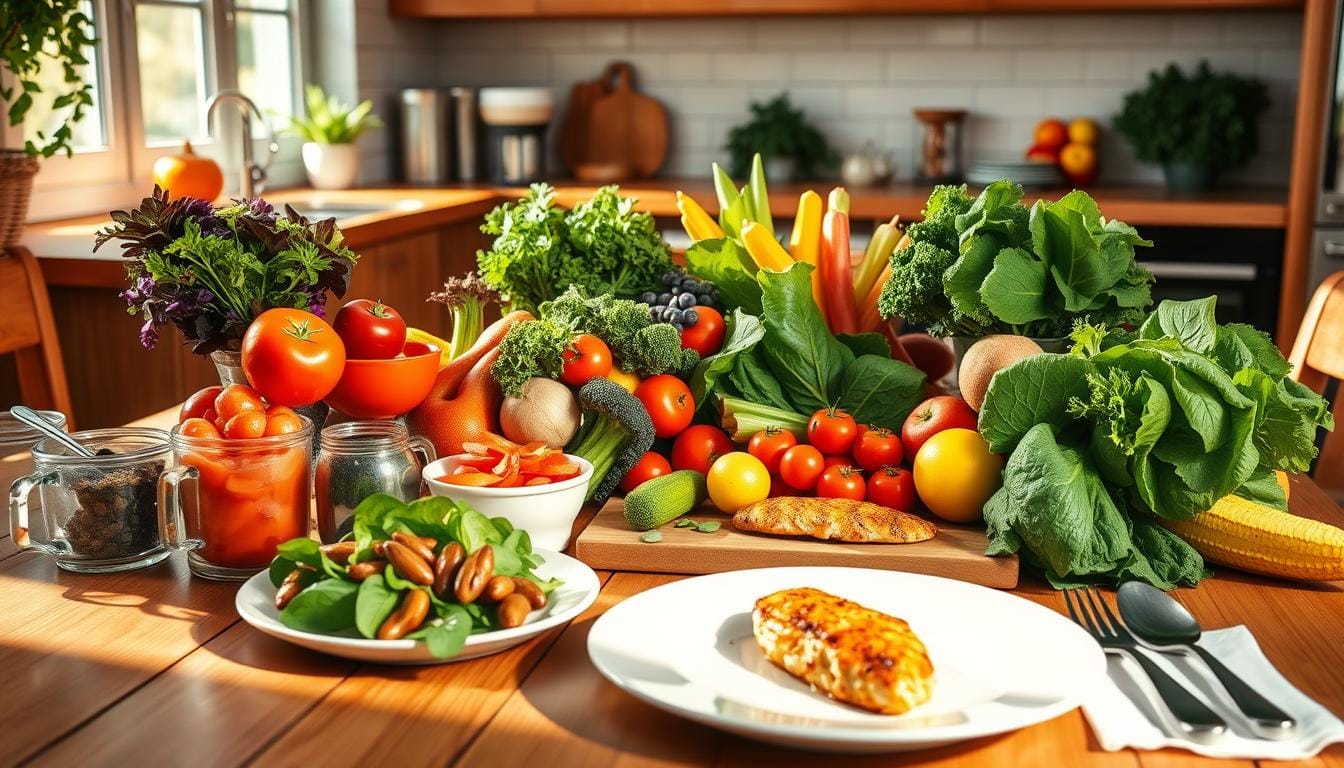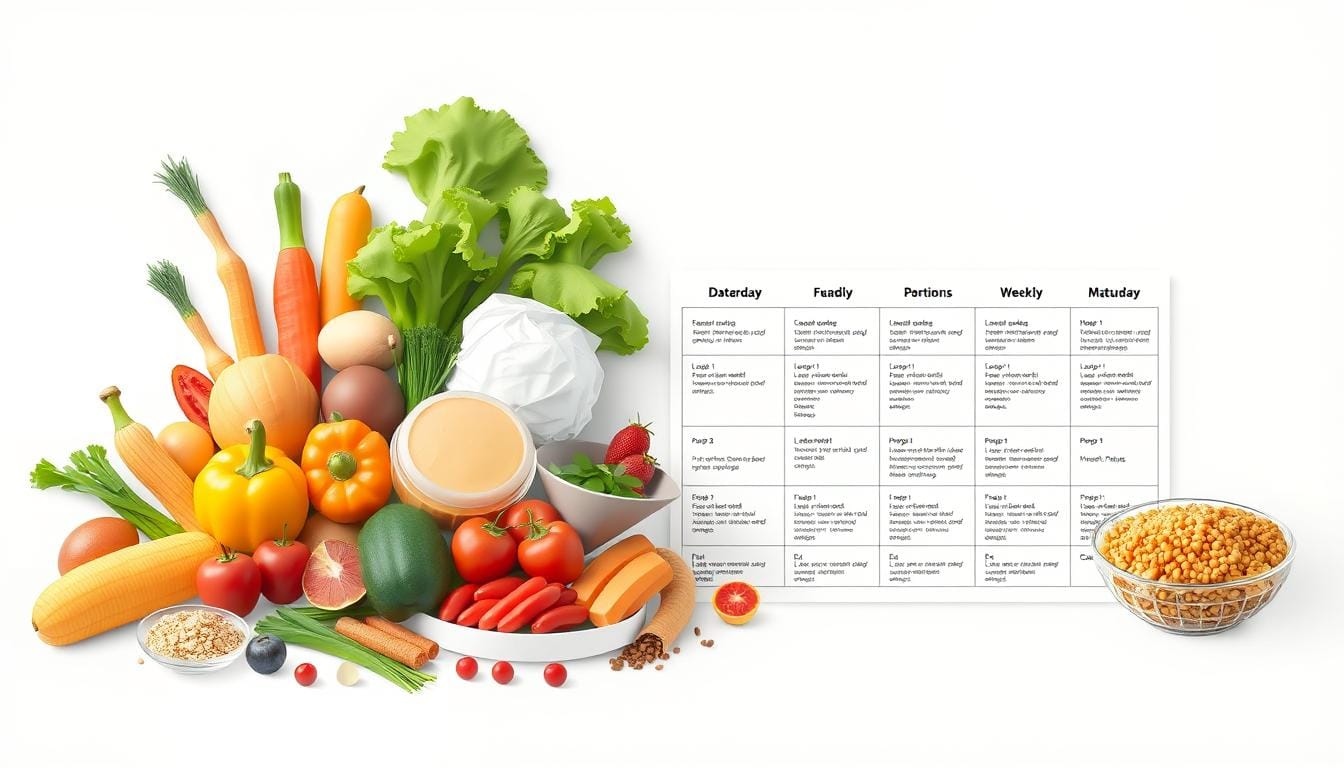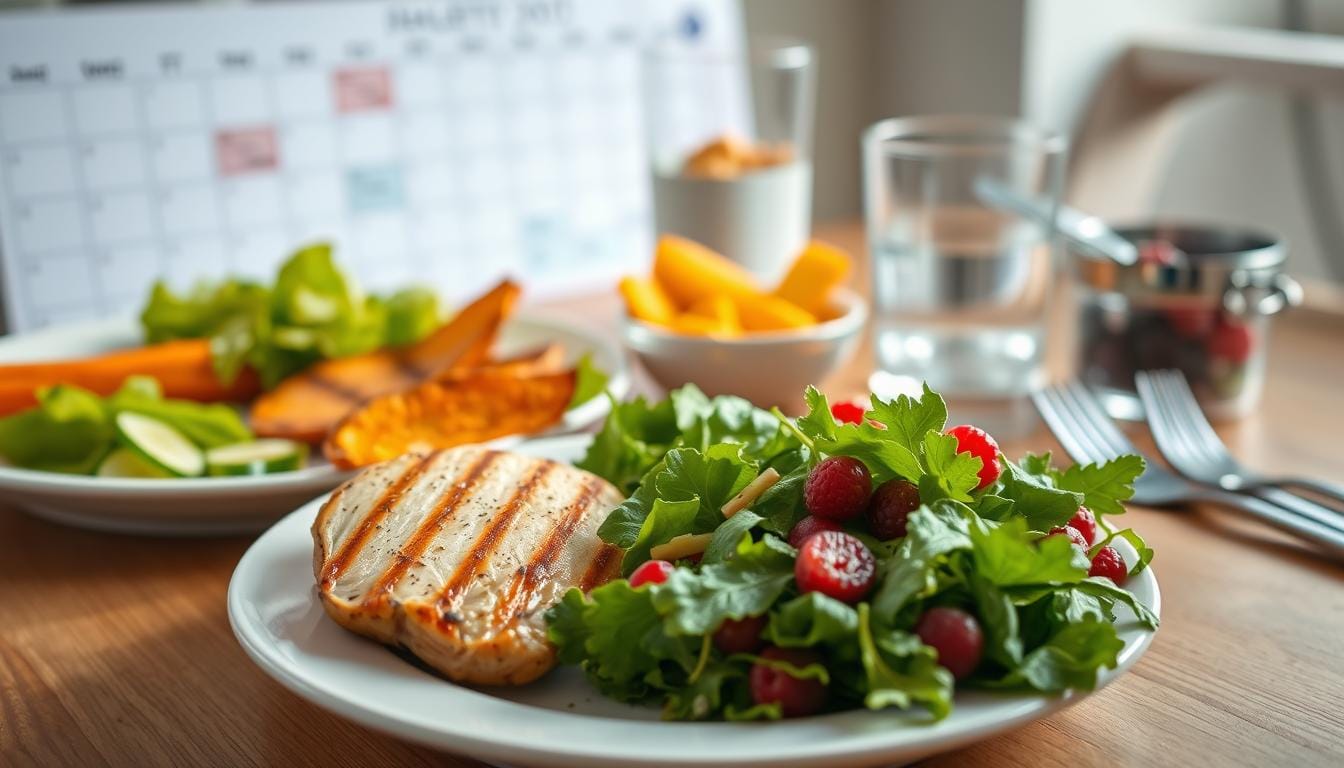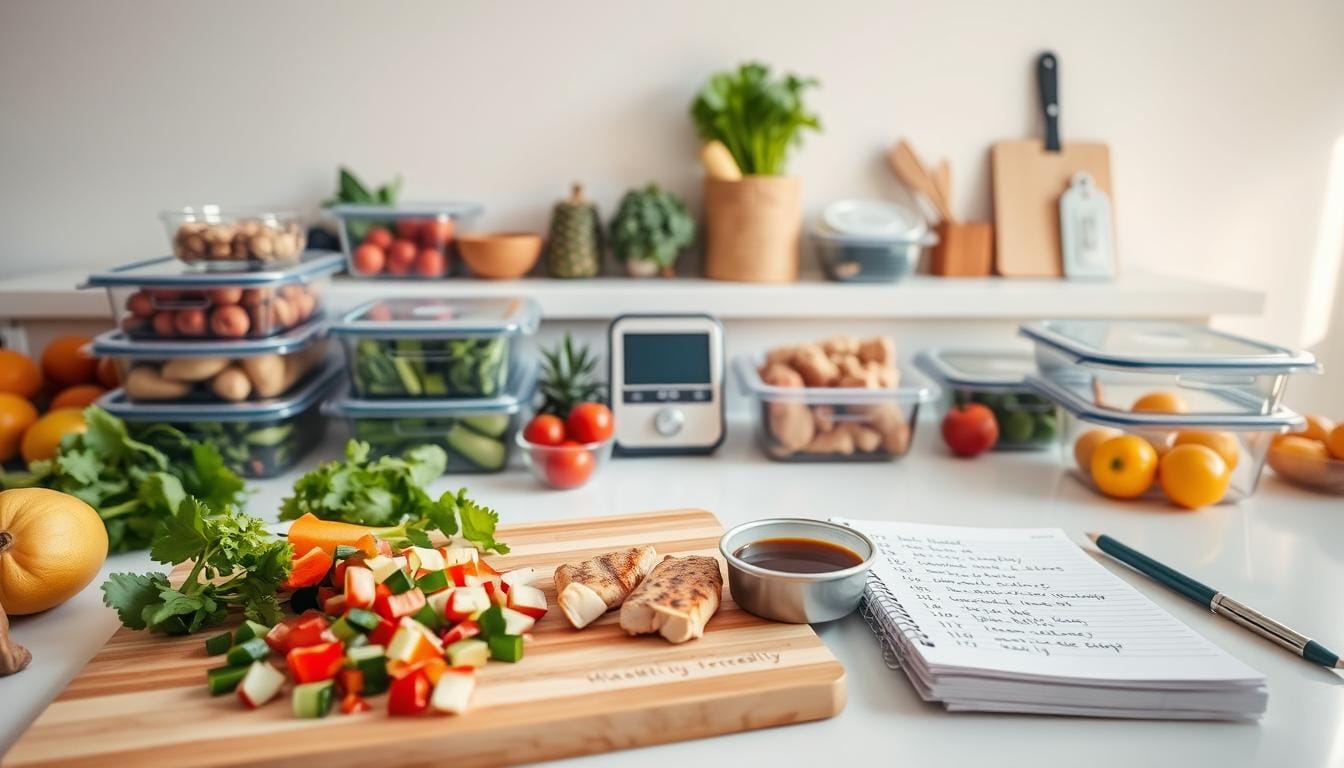
Living with diabetes doesn’t mean you have to give up on tasty meals. Our 7-day diabetic meal planner is your guide to eating well and managing your blood sugar1. With 37 million Americans dealing with type 2 diabetes, it’s more important than ever to know how to eat right1.
Imagine turning your daily meals into a celebration of health. This 7-day diabetic meal plan PDF makes that dream come true. We’ll show you how to enjoy meals that are good for you and keep your blood sugar in check2.
Every meal is planned with care, following guidelines for the right amount of carbs. This helps keep your blood sugar stable2. Our meal planner takes the stress out of eating, giving you tasty options that support your health.
If you’re new to diabetes or looking to improve your diet, this meal plan offers hope. You’ll learn that eating well can be both fun and healing3. Each meal has 2-3 carb servings, helping you reach your wellness goals3.
Get ready for a culinary journey that’s good for your body and pleases your taste buds. Your journey to better health begins here.
Table of Contents
Understanding Diabetes and Meal Planning Basics
Managing diabetes begins with knowing how food affects your body. About 34.2 million Americans have diabetes, making meal planning key for keeping blood sugar levels healthy4. A diabetic diet plan pdf can be a great help in managing nutrition and wellness.
The Role of Blood Sugar Management
Keeping blood sugar in check is vital for diabetes management. Type 1 diabetes affects 5-10% of cases, while Type 2 diabetes makes up 90-95%4. It’s important to know how food affects glucose levels to make an effective meal plan.
Essential Nutritional Components
A balanced diet for diabetics should include:
- Consistent carbohydrate intake
- Lean proteins
- Healthy fats
- Fiber-rich foods
The National Institutes of Health suggest 45% to 65% of daily calories should come from carbs, but needs vary5. Eating too many carbs can raise blood glucose levels a lot4.
Daily Caloric Needs for Diabetics
Your daily calorie needs depend on age, weight, and activity level. A 7-day meal plan usually aims for about 2,000 calories a day5. The Diabetes Plate Method suggests eating half your plate with non-starchy veggies, one-quarter with lean protein, and one-quarter with whole grains4.
By grasping these basics, you can create a personalized plan to manage diabetes through nutrition and meal planning.
7-Day Diabetic Meal Plan PDF: Complete Guide

Creating a good diabetic meal plan can change how you eat and manage your blood sugar. Our 7-day diabetic meal plan PDF is a detailed guide for healthy eating. It supports your journey to better health6. The plan helps keep your blood sugar stable and offers tasty, nutritious meals7.
Our healthy diabetic meal plan PDF has many great features:
- It has a daily calorie goal of 1,500 calories6
- It balances protein and carbs for your meals
- It’s flexible to fit your personal dietary needs
The meal plan uses key nutrition tips from diabetes experts8. It focuses on making meals that help control blood sugar well7.
| Meal Plan Characteristics | Daily Average |
|---|---|
| Total Calories | 1,500 calories |
| Protein | 80-90g |
| Carbohydrates | 120-140g |
| Fiber | 30-40g |
Our meal plan ideas focus on nonstarchy vegetables and balanced foods7. It uses the plate method to ensure each meal is full of nutrients7.
By sticking to this meal plan, you can better control your blood sugar and might even lose weight6. The PDF format makes it simple to use and follow, helping you plan your meals every day.
Balancing Carbohydrates in Your Daily Diet
Understanding carbohydrates is key for managing diabetes and making good diabetic recipes. Carbs are important for controlling blood sugar and nutrition for people with diabetes9.
When planning your diet, choose whole, unrefined carbs. They help control blood sugar and support digestion9. These foods are full of nutrients and offer great benefits:
- Boost digestion
- Lower cholesterol
- Maintain steady blood sugar levels
Types of Carbs to Include and Avoid
Not all carbs are the same. Your diabetic recipes should focus on:
- Whole grains like brown rice
- Fiber-rich vegetables
- Low-fat dairy
- Fresh fruits
Stay away from simple and refined carbs. They can raise heart disease risk9. Avoid foods with lots of sugar.
Recommended Carb Portions per Meal
The Diabetes Plate Method is a good way to portion carbs. Try to fill your plate with:
- Half non-starchy vegetables
- One-quarter lean protein
- One-quarter healthy carbohydrates10
Glycemic Index Understanding
Choosing low glycemic index foods helps manage blood sugar better. Your diabetic recipes should include foods that give steady energy without big blood sugar spikes11.
Pro tip: Always consult with a healthcare provider to personalize your carbohydrate intake based on individual needs.
Protein and Fat Requirements for Diabetics
Creating a diabetic meal plan for weight loss means knowing about protein and fat. What you eat affects your blood sugar and helps you stay at a healthy weight12.
A good diabetic meal plan focuses on the right protein and fat. Adults should aim for certain amounts each day:
- Protein intake: 3-4 ounces per meal12
- Fat consumption: 20-35% of total daily calories12
- Saturated fat: Less than 10% of total calories
Choosing the right protein is key for your meal plan. Lean proteins help keep blood sugar steady and make you feel full13. Good protein sources include:
- Salmon (48g protein per serving)
- Chicken
- Eggs
- Legumes
“Balanced nutrition is key to managing diabetes and supporting weight loss goals.”
Use the plate method to plan your meals. Put one-fourth of your plate to lean protein. This method helps control portions and keeps your diet balanced12.
Keep in mind, everyone’s needs are different. Talking to a registered dietitian can make your meal plan more personal12.
Breakfast Options and Meal Ideas
Starting your day right is key when you have diabetes. A good breakfast helps keep your blood sugar stable and gives you the nutrients you need. Your meal plan should include balanced, healthy breakfasts that help you reach your health goals.
Quick and Easy Breakfast Recipes
Making a diabetes-friendly breakfast is easy. Here are some simple yet healthy options:
- Poached egg with avocado on Ezekiel bread14
- Greek yogurt with berries and chia seeds
- Vegetable omelet with a small portion of whole-grain toast
Make-Ahead Breakfast Solutions
Busy mornings need smart planning. Try these make-ahead breakfasts to make your meal plan easier:
- Overnight chia seed pudding
- Egg muffins with vegetables
- Protein smoothie packs
| Breakfast Option | Carbohydrates | Protein |
|---|---|---|
| Poached Egg & Avocado Toast | 39g15 | 15g |
| Greek Yogurt with Berries | 15g15 | 20g |
| Vegetable Omelet | 10g15 | 25g |
Blood Sugar-Friendly Morning Choices
When planning your meals, focus on balanced nutrition. Use the diabetes plate method for breakfast. It suggests ¼ lean protein, ¼ high-fiber carbs, and ½ non-starchy veggies16. Try to keep added sugars under 6% of your daily calories14.
Pro Tip: Consistency is key in managing blood sugar levels through breakfast choices.
Lunch and Dinner Meal Planning Strategies
Creating a 7-day diabetic meal plan PDF needs careful planning for lunch and dinner. Your meal planner should focus on meals that are balanced and rich in nutrients. These meals help manage blood sugar levels well15.

- Include protein at each main meal in moderate amounts15
- Limit starchy vegetables to 2-3 tablespoons per meal15
- Use unsaturated oils instead of saturated fats15
Here’s a sample lunch idea that fits within a diabetic meal plan:
| Ingredient | Quantity | Carbohydrate Content |
|---|---|---|
| Low-sodium pinto beans | 2/3 cup | 15g |
| Chopped spinach | 1 cup | 1g |
| Chopped tomatoes | 1/4 cup | 2g |
| Bell peppers | 1/4 cup | 2g |
| Cheese | 1 oz | 1g |
| Salsa | 1 tbsp | 1g |
The total carbohydrate content for this meal is about 30g. This fits well with diabetic meal planning guidelines17. Your meal planner should aim to create meals that are balanced and nutritious. These meals should also help control blood sugar levels.
Pro tip: Vegetables can be eaten in unlimited amounts. They are high in fiber and low in calories15.
Smart Snacking for Blood Sugar Control
Managing diabetes means choosing snacks wisely to keep blood sugar stable. Your diabetic diet plan pdf is key for planning snacks that help you stay healthy18.
Portion-Controlled Snack Ideas
For your diabetic meal plan printable, pick snacks that are full of nutrients. Here are some great options:
- Whole grain crackers with lean protein19
- Greek yogurt with berries19
- Sweet potato slices with hummus19
- Steel cut oatmeal with nuts19
Timing Your Snacks Effectively
Snack timing is key for managing blood sugar. Experts say to eat small meals every 3 to 4 hours to keep glucose steady18. Follow these tips:
- Eat a snack between meals if your blood sugar is dropping
- Choose snacks with a mix of protein and complex carbohydrates19
- Aim for portion sizes that prevent dramatic blood sugar fluctuations
Always talk to your healthcare provider to make your snacking plan fit your needs2.
Meal Prep Tips and Storage Guidelines
Creating a good diabetic meal plan needs smart prep and storage. Meal prepping is key for managing blood sugar17. It saves time, reduces stress, and keeps your diet consistent all week.

- Batch cook proteins and vegetables on weekends
- Use air-tight containers for proper food storage
- Portion meals in advance to control serving sizes
- Rotate meal ingredients to maintain variety
Good meal prep helps control blood sugar. It’s wise to prep dishes for several days17. For example, make Chipotle-Lime Cauliflower Taco Bowls and store them for easy lunches all week.
“Meal prep is not just about saving time, it’s about maintaining consistent nutrition for better diabetes management.”
Here are some storage tips for your meal plan:
| Food Type | Storage Method | Maximum Storage Time |
|---|---|---|
| Cooked Proteins | Refrigerated in air-tight container | 3-4 days |
| Chopped Vegetables | Sealed plastic containers | 5-7 days |
| Prepared Meals | Refrigerated in portion containers | 3-5 days |
Proper meal prep helps keep your blood sugar stable14. It’s a big part of managing your diabetes.
Shopping List and Ingredient Preparation
Creating a diabetic friendly recipes PDF begins with a well-planned grocery list. Choosing the right ingredients makes meal prep easier and helps manage blood sugar20. Your list should include foods rich in nutrients but low in carbs to avoid quick spikes in blood sugar.
Focus on lean proteins like chicken, turkey, and fish, and also plant-based options like beans and lentils20. Add healthy fats from olive oil, avocados, and nuts. Fill your cart with lots of vegetables, choosing low-carb, non-starchy ones for their nutritional value and minimal blood sugar impact20.
Remember, portion control is key in diabetic meal planning. Choose ingredients that fit recommended serving sizes, like 3-ounce meat portions and measured grains20. Your diabetic friendly recipes PDF will help you make tasty, healthy meals that keep your blood sugar stable and your taste buds happy.
Weekly Grocery List Template
Make a template with sections for proteins, veggies, fruits, whole grains, and healthy fats. Pick items that help you meet your nutritional goals and make cooking easier20. Having the right ingredients in your kitchen is the first step to managing diabetes through diet.
Kitchen Essentials for Diabetic Cooking
Get tools for healthy cooking like baking, grilling, and roasting21. Buy measuring cups, food scales, and portion control containers for precise nutrition. These tools are essential for following your diabetic friendly recipes PDF and supporting your health journey.
